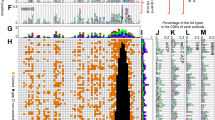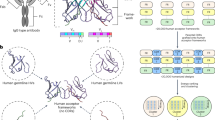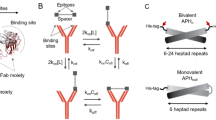Abstract
The binding parameters of randomly immobilized protein 315 and Fv fragments, as well as site-specifically immobilized Fab′ fragments, have been measured for a small hapten (MW=341 Daltons) and a large synthetic antigen (MW=50 kD). Immobilized Fv fragments had the highest binding capacities; hence, removing unnecessary protein domains can be beneficial for improving the total capacity of an immunosorbent. For all immunosorbents, high protein loadings led to relatively low specific activities (n values). This effect was reversible, however, as the loss of immobilized antibody upon prolonged storage partially restored the specific activity. At high loadings the specific activity of immobilized whole antibody was lower for the large antigen than for the small hapten, whereas no effect of hapten size on n was evident for either immobilized Fab′ or Fv fragments. Although a fraction of immobilized antibody was inactive at the higher loadings, EPR spectroscopy revealed no significant changes in the conformation of active immobilized antibody.
This is a preview of subscription content, access via your institution
Access options
Subscribe to this journal
Receive 12 print issues and online access
$209.00 per year
only $17.42 per issue
Buy this article
- Purchase on Springer Link
- Instant access to full article PDF
Prices may be subject to local taxes which are calculated during checkout
Similar content being viewed by others
References
Janson, J.-C. 1984. Large-scale affinity purification—state of the art and future prospects. Trends Biotechnol. 2: 31–38.
Chase, H.A. 1984. Affinity separations utilising immobilised monoclonal antibodies—a new tool for the biochemical engineer. Chem. Eng. Sci. 39: 1099–1125.
Klausner, A. 1987. Immunoassays flourish in new markets. Bio/Technology 5: 551–56.
Carlsson, R., Glad, C. and Borrebaeck, C.K.A. 1989. Monoclonal antibodies into the '90s: the all-purpose tool. Bio/Technology 7: 567–73.
Scott, M.G. 1985. Monoclonal antibodies—approaching adolescence in diagnostic immunoassays. Trends Biotechnol. 3: 170–75.
Lord, J.M., Roberts, L.M., Thorpe, P.E. and Vitetta, E.S. 1985. Immunotoxins. Trends Biotechnol. 3: 175–79.
Boitieux, J.L., Desmet, G., Wilson, G. and Thomas, D. 1990. The specific immobilization of antibody fragments on membrane for the development of multifunctional biosensors. Ann. N. Y. Acad. Sci. 613: 390–395.
North, J.R. 1985. Immunosensors:antibody-based biosensors. Trends Biotechnol. 3: 80–86.
Jimbo, Y. and Saito, M. 1988. Orientation-controlled immobilization of protein molecules on thin film organic films deposited by the plasma technique. J. Mol. Electron. 4: 111–18.
Spitznagel, T.M., Jacobs, J.W. and Clark, D.S. Random and site specific immobilization of catalytic antibodies. Enz. Microb. Technol. Submitted
Janda, K.D., Ashley, J.A., Jones, T.M., McLeod, D.A., Schloeder, D.M. and Weinhouse, M.I. 1990. Immobilized catalytic antibodies in aqueous and organic solvents. J. Am. Chem. Soc. 112: 8886–8888.
Eveleigh, J.W. and Levy, D.E. 1977. Immunochemical characteristics and preparative application of agarose-based immunosorbents. J. Solid-Phase Biochem. 2: 45–78.
Olson, W.C., Spitznagel, T.M. and Yarmush, M.L. 1989. Dissociation kinetics of antigen-antibody interactions: studies on a panel of anti-albumin monoclonal antibodies. Mol. Immunol. 26: 129–36.
Guzov, V.M. and Usanov, S.A. 1988. Optimization of antibodies against carcinoembryonic antigen on insoluble matrices. Equilibrium parameters of the interaction of immobilized antibodies with antigen. Biokhimiya. 53: 1772–1782.
Strauss, W.M., Broze, G.J., Miletich, J.P. and Null, H.R. 1987. Mass transfer in agarose-based immunoadsorbent columns. Biotechnol. Appl. Biochem. 9: 462–477.
Sada, E., Katoh, S., Sukai, K., Tohma, M. and Kondo, A. 1986. Adsorption equilibrium in immuno-affinity chromatography with polyclonal and monoclonal antibodies. Biotechnol. Bioeng. 28: 1497–1502.
Eisen, H.N., Simms, E.S. and Potter, M. 1968. Mouse myeloma proteins with antihapten antibody activity. The protein produced by plasma cell tumor MOPC-315. Biochemistry 7: 4126–34.
Haselkorn, D., Friedman, S., Givol, D. and Pecht, I. 1974. Kinetic mapping of the antibody combining site by chemical relaxation spectrometry. Biochemistry 13: 2210–2222.
Hochmann, J., Inbar, D. and Givol, D. 1973. An active antibody fragment (Fv) composed of the variable portions of heavy and light chains. Biochemistry 12: 1130–35.
Baldwin, E.P. 1989. Construction, expression, and mutagenesis of genes encoding the variable region domain of MOPC315, p. 68. Thesis, Department of Chemistry, University of California, Berkeley.
Lin, J.N., Chang, I.-N., Andrade, J.D., Herron, J.N. and Christensen, D.A. 1991. Comparison of site-specific coupling chemistry for antibody immobilization on different solid supports. J. Chromatog. 542: 41–54.
Lin, J.N., Andrade, J.D. and Chang, I.-N. 1989. The influence of adsorption of native and modified antibodies on their activity. J. Immunol. Meth. 125: 67–77.
Sportsman, J.R. and Wilson, G.S. 1980. Chromatographic properties of silica-immobilized antibodies. Anal. Chem. 52: 2013–2018.
Ernst-Cabrera, K. and Wilchek, M. 1988. High-performance affinity chromatography. Trends Anal. Chem. 7: 58–63.
Parikh, I., March, S. and Cuatrecasas . 1974. Topics in the methodology of substitution reactions with agarose. Methods in Enzymol. 34: 77–102.
Inbar, D., Rotman, M. and Givol, D. 1971. Crystallization with hapten of the Fab′ fragment from a mouse IgA myeloma protein with antidinitrophenyl activity. J. Biol. Chem. 246: 6272–75.
Goetzl, E.J. and Metzger, H. 1970. Affinity labeling of a mouse myeloma protein which binds nitrophenyl ligands. Kinetics of labeling and isolation of a labeled peptide. Biochemistry 9: 1267–78.
Weetall, H.H. 1976. Covalent coupling methods for inorganic support materials. Methods in Enzymol. 44: 134–148.
Ternynck, T. and Avrameas, S. 1976. Polymerization and immobilization of proteins using ethylchloroformate and glutaraldehyde, p. 29–35. In: Immuno-adsorbents in protein purification. Ruolsahti, E. (Ed.). University Park Press, Baltimore, MD.
Skerker, P.S. and Clark, D.S. 1988. Catalytic properties and active-site structural features of immobilized horse liver alcohol dehydrogenase. Biotechnol. Bioeng. 32: 148–58.
Hammers, G.G. 1982. Regulation of enzyme activity, p. 161–162. In: Enzyme Catalysis and Regulation. Hammes, G. G. (Ed.). Academic Press, New York.
Rittenberg, M.B. and Amkraut, A.A. 1966. Immunogenicity of trinitrophenyl-hemocyanin: production of primary and secondary anti-hapten precipitins. J. Immunol. 97: 421–430.
Little, R.J. and Eisen, H.N. 1967. Preparation of immunogenic 2,4-dini-trophenyl and 2,4,6-trinitrophenyl proteins. Methods Immunoi. Immunochem. 1: 128–133.
Gabel, D. 1973. The denaturation by urea and guanidinium chloride of trypsin and N-acetylated-trypsin derivatives bound to sephadex and agarose. Eur. J. Biochem. 33: 348–356.
Author information
Authors and Affiliations
Rights and permissions
About this article
Cite this article
Spitznagel, T., Clark, D. Surface-Density and Orientation Effects on Immobilized Antibodies and Antibody Fragments. Nat Biotechnol 11, 825–829 (1993). https://doi.org/10.1038/nbt0793-825
Received:
Accepted:
Issue Date:
DOI: https://doi.org/10.1038/nbt0793-825
This article is cited by
-
Bioinspired detoxification of blood: The efficient removal of anthrax toxin protective antigen using an extracorporeal macroporous adsorbent device
Scientific Reports (2018)
-
Two-layer reflectometric interference spectroscopy-based immunosensing for C-reactive protein
Microchimica Acta (2015)
-
A comparative study on antibody immobilization strategies onto solid surface
Korean Journal of Chemical Engineering (2013)
-
Increase in the detection sensitivity of a lateral flow assay for a cardiac marker by oriented immobilization of antibody
BioChip Journal (2011)



